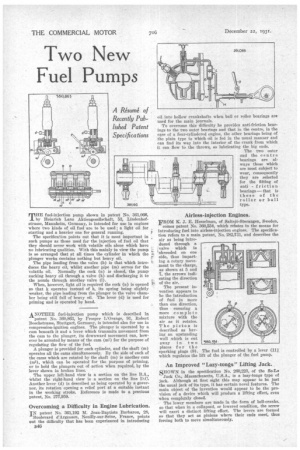Two New Fuel Pumps
Page 60

If you've noticed an error in this article please click here to report it so we can fix it.
MHE fuel-injection pump shown in patent No. 361,066, by Heinrich Lanz Aktiengesellschaft, 53, Lindenhofstrasse, Mannheim, Germany, is intended for use in engines where two kinds of oil fuel are to be used ; a light oil for starting and a heavier one for general running. The specification points out that it is most important in such pumps as those used for the injection of fuel oil that they should never work with volatile oils alone which have no lubricating qualities. With this mainly in view the pump is so arranged that at all times the cylinder in which the plunger works contains nothing but heavy oil.
The pipe leading from the valve (b) is that which introduces the heavy oil, whilst another pipe (m) serves for the volatile oil. Normally the cock (n) is closed, the pump sucking heavy oil through a valve (h) and discharging it to the nozzle through another valve (1).
When, however, light oil is required the cock (n) is opened so that k operates instead of h, its spring being slightly weaker, the pipe leading from the plunger to the valve chamber being still full of heavy oil. The lever .(d) is used for priming and is operated by hand.
ANOTHER fuel-injection pump which is described in patent No. 360,863, by Prosper LOrange, 91, Robert Boschstrasse, Stuttgart, Germany, is intended also for use in compression-ignition engines. The plunger is operated by a cam beneath it and a lever which transmits movement from the cam to the plunger, its downward movement can, however be arrested by means of the cam (ml) for the purpose of regulating the flow of the fueL A plunger is provided for each cylinder, and the shaft (m) operates all the cams simultaneously. By the side of each of the cams which are rotated by the shaft (m) is another cam (ml), which can be operated for the purpose of priming, or to hold the plungers out of action when required, by the lever shown in broken lines.
The upper left-hand view is a section on the line B.A., whilst the right-hand view is a section on the line D.C. Another lever (d) is described as being operated by a governor, ita rotation opening a relief port at a suitable instant in the working stroke. Reference is made to a previous patent, No. 277,959.
Overcoming a Difficulty in Engine Lubrication.
IN patent No. 361,192 M. Jean-Baptiste Barbarou, 28, Boulevard d'Argenson, Neuilly-sur-Seine, France, points out the difficulty that has been experienced in introducing B46
Airless-injection Engines.
FRO3ft K. J. E. Hessehnan, of Saltsjfi-Storangen, Sweden,
comes patent No. 360,554, which relates to the means for introducing fuel into airless-injection engines. The specification refers to a main patent, No. 282,731, and describes the air as being introdueed through a ;valve which is 'shrouded on one side, thus imparting a rotary movement to the charge, as shown at 5 and 7, the arrows indicating the direction of the air.
The present invention appears to be the introduction of fuel in more than one direction, thus ensuring a more complete mixture with the air as it rotates. The piston is described as baying an upstanding wall which is cut away in two places f or the sparking plugs (9). The fuel is controlled by a lever (11). which regulates the lift of the plunger of the fuel pump.
An Improved "Lazy-tongs" Lifting Jack..
SHOWN in the specification No. 260,223, of the So-Lo Jack Co., Massachusetts, 'U.S.A.. is a lazy-tongs type of jack. Although at first sight this may appear to be just the usual jack of its type, it has certain novel features. The main object of the invention would appear to be the provision of a device which will produce a lifting effect, even when completely closed. The lower members are made in the form of bell-cranks. so that when in a collapsed, or lowered condition, the screw will exert a distinct lifting effect. The levers are formed so that they act as pinions where their ends meet, thus forcing both to move simultaneously,




























































































